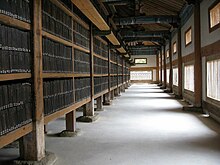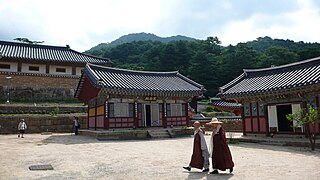Haeinsa
| Haeinsa Temple, Janggyeong Panjeon, repository of the Tripitaka Koreana tablets | |
|---|---|
|
UNESCO world heritage |
|

|
|
| Daejeokkwangjeon main hall |
|
| National territory: |
|
| Type: | Culture |
| Criteria : | (iv) (vi) |
| Reference No .: | 737 |
| UNESCO region : | Asia and Pacific |
| History of enrollment | |
| Enrollment: | 1995 (session 19) |
| Korean spelling | |
|---|---|
| Korean alphabet : | 해인사 |
| Hanja : | 海印 寺 |
| Revised Romanization : | Haeinsa |
| McCune-Reischauer : | Mr = Haeinsa |
Haeinsa (해인사, 海印 寺) is one of the main temples of the Buddhist Jogye order (대한 불교 조계종, 大 韓 佛 敎 曹溪 宗). The temple is located on the flank of Mount Gayasan (가야산, 伽 倻 山), near Daegu in the south of Gyeongsangnam Province in South Korea . In 1995 the temple complex was included in the UNESCO World Heritage List as a World Heritage Site .
meaning
Haeinsa is one of the three temples of the three jewels . It stands for Dharma or the Buddhist teaching . The temple is still actively used today as a Seon monastery (선, 禪). The influential Lama Seongcheol (성철, 性 徹), who was considered the living Buddha in Korea , also lived here. He was famous for his ascetic way of life and the clarity of his teaching. Seongcheol died here in 1993.
The special significance of the Haeinsa temple lies in the fact that it houses the Tripitaka Koreana , the printing plates for one of the most extensive collections of Buddhist scriptures, in its Janggyeong Panjeon warehouse . The collection includes 81,258 plates. The printing plates have been stored there since 1398.
Surname
The syllable Sa in Haeinsa means temple. The part of the name Haein is derived from 'Haein samadhi' from the Avatamsaka Sutra . It states that the reason of everything reveals itself to a fear-free (pain-free, calm) consciousness, like a reflection on a calm surface of water . The name is therefore a reference to a didactic poem ( sutra ) instead of carrying a meaning in itself. The numerous translations of the name of the monastery are therefore mostly not literal translations by Haein , but an attempt to summarize the content of the didactic poem compactly. The numerous translations of the name Haeinsa therefore differ considerably in some cases.
history
The temple was founded in 802. According to a legend, the wife of King Aejang (애장왕, 哀 莊王), of the united Silla kingdom, was seriously ill. However, the two Buddhist monks Suneung and his disciple Ijeong managed to heal her when they returned from China. Out of gratitude, the king is said to have ordered the original temple to be built. But there are also other representations, so that the exact origin is not certain.
During the rise of the Goryeo Empire in the 10th century, the then abbot Huirang managed to win support and protection from King Taejo during his reign (918–943). The temple complex was extensively renovated during this time. Further renovations followed in 1488, 1622 and 1644. In 1817 the temple complex burned down almost completely and was rebuilt in the following years. During further renovation work in 1964, a robe of King Gwanghaegun , who had initiated the renovation in 1622, as well as an inscription in one of the ridge beams were found.
During the Korean War in September 1951, after landing at Incheon, the North Korean troops were repulsed. In the area of the Haeinsa temple, however, a North Korean unit of around 1,000 soldiers managed to entrench themselves. The temple should therefore be bombed. Kim Young-hwan, a Korean colonel and head of the air force unit that was supposed to coordinate the operation, refused to implement the US military's order. With this refusal to give orders, the temple complex survived the Korean War.
description
The main hall Daejeokkwangjeon (대적광전, 大 寂光 殿: Hall of the Great Silence and Light) is unusual because it is not, as is usual in most temples, dedicated to Buddha Siddhartha Gautama (in Korean Seokgamoni ), but to Buddha Vairocana , a transcendent Buddha.
The temple complex contains a number of other works of art from the Korean national treasure.
Janggyeong Panjeon (National Treasure No. 52)
Janggyeong Panjeon is the name for a complex of four buildings. They contain more than 80,000 wooden printing blocks from the Tripitaka Koreana . The buildings are among the largest wooden buildings for storage purposes in the world and were added to the list of the National Treasures of South Korea by the Korean government on December 20, 1962 .
In total, the Haeinsa temple complex was hit by 7 major fires, which caused serious damage to the monastery. However, the Janggyeong Panjeon complex remained undamaged each time. This is particularly noteworthy for the seven-year Japanese war of invasion from 1592 to 1598, the great fire in 1818 that destroyed almost the entire monastery, and the clashes during the Korean War (see above). The Janggyeong Panjeon Complex therefore represents the oldest part of the buildings in the temple complex today.
The building complex was erected in the 15th century, but the exact date is unclear. It is believed, however, that King Sejo had the complex renovated and expanded in 1457. The complex consists of 4 warehouses arranged in a rectangle. Since they were designed as a warehouse from the start, they are functional and unadorned. The northern nave houses the philosophical prose texts and is therefore called Beopbojeon ( Hall of Dharma , roughly: Hall of Laws ). The southern nave houses the teaching texts, mostly written in rhymes, and is called Sudarajang ( Hall of Sutras , roughly Hall of Discourses ). The two long houses each have a length of 60.44 m, a width of 8.73 m and a height of 7.8 m. Both are divided into 15 sections, each consisting of a large and two smaller adjoining rooms. Between the front sides of the two long houses are two shorter buildings, in which 2 smaller libraries are housed, but also works of art are kept.
Tripitaka Koreana (National Treasure No. 32)
The Tripitaka Koreana contains 81,258 wooden printing plates for one of the most comprehensive collections of Buddhist scriptures. In Korean it is also called Palman Daejanggyeong (팔만 대장경), which means eighty thousand tripitaka , because of the more than eighty thousand printing blocks. Only particularly resistant types of wood, mainly cherry and pear trees, were used for the panels. The wood was boiled in salt water to make it even more durable, and then dried very slowly and gently to prevent it from cracking. In Janggyeong Panjeon there are optimal storage conditions.
The first version of the Tripitaka Koreana was created around the year 1087. However, this was destroyed in armed conflict during one of the Mongol invasions in 1232. Due to surviving prints, the printing plates were recreated in the 16 years from 1236 to 1251. So far, no errors and no subsequent corrections have been discovered on the printing plates.
World Heritage
Haeinsa Temple, Janggyeong Panjeon, repository of the Tripitaka Koreana tablets , was inscribed on the UNESCO World Heritage List in 1995 by decision of the 19th session of the World Heritage Committee . The temple with the Seokguram cave temple and the Bulguksa temple and the Jongmyo shrine is one of the first world cultural heritage sites in South Korea, which joined the World Heritage Convention in 1988. The World Heritage Site includes all of the components of the Haeinsa Temple Complex including the Janggyeong Panjeon and the Tablets of the Tripitaka Koreana.
The reason for the entry states, among other things:
“The storage buildings were specially developed for natural ventilation and adjust the temperature and humidity to the climatic conditions, thereby protecting the wooden panels from rodents and insect infestation for around 500 years. The Haeinsa Temple Complex is a famous pilgrimage destination not only among Korean Buddhists but also among Buddhists and scholars from around the world. "
The entry was made on the basis of criteria (iv) and (vi).
“(Iv): The Haeinsa Temple's storage buildings are unique both in terms of their antiquity as far as this specialized type of structure is concerned, as well as for the remarkably effective solutions developed in the 15th century to the problem of storage of the 80,000 wooden tablets that were used to print the Buddhist scriptures (Tripitaka Koreana) and to keep them from decaying. "
“(Vi): The Janggyeong Panjeon and its unique collection of the wooden tablets of the Tripitaka Koreana from the 13th century, which are outstanding for their craftsmanship and excellent execution of engraving techniques, occupy an exceptional position in the history of Buddhism as the most complete and accurate Text collection of Buddhist teaching texts in the world. "
Picture gallery
See also
literature
- Tripitaka Depository at Haeinsa Temple . In: Cultural Heritage Administration of South Korea (ed.): World Heritage in Korea . 2011, p. 28-39 (English).
Web links
- Haeinsa Temple on the UNESCO World Heritage Center website ( English and French ).
- Lewis R. Lancaster and Sung-bae Park: The Korean Buddhist Canon: A Descriptive Catalog ( Memento of September 27, 2007 in the Internet Archive ) (English).
- Haeinsa Temple (해인사). In: Visit Korea. Korea Tourism Organization, accessed May 6, 2014 .
- The Tripitaka Koreana - Korea's "Buddhist Bible". (No longer available online.) In: metropolis. arte.tv, October 22, 2005, formerly in the original ; accessed on May 6, 2014 . ( Page no longer available , search in web archives )
- Tripitaka Koreana. In: Encyclopedia Britannica. Retrieved May 6, 2014 .
Individual evidence
- ↑ a b c d UNESCO World Heritage Center: Haeinsa Temple Janggyeong Panjeon, the Depositories for the Tripitaka Koreana Woodblocks. In: whc.unesco.org. Retrieved February 6, 2017 .
- ^ A b c Asian Historical Architecture. Retrieved May 6, 2014 .
- ^ Tripitaka Koreana. History. (No longer available online.) In: Homepage Haeinsa. 2002, archived from the original on May 25, 2014 ; accessed on May 6, 2014 . Info: The archive link was inserted automatically and has not yet been checked. Please check the original and archive link according to the instructions and then remove this notice.
- ↑ Martin Brauen: Melting Buddha. NZZ, October 5, 2011, accessed on May 6, 2014 (NZZ report on an art project, with historical review).
- ^ World Heritage List. (PDF) Hainsa. UNESCO, October 21, 1994, pp. 1–14 , accessed on May 6, 2014 (English).
- ↑ Haeinsa Daejanggyeongpan. Palman Daejanggyeong. In: Visit Korea. Korea Tourism Organization, accessed May 6, 2014 .
- ^ English Haeinsa Temple Janggyeong Panjeon, the Depositories for the Tripitaka Koreana Woodblocks , German translation according to the World Heritage List. In: Unesco.de. Retrieved February 5, 2017 . with adaptation of the transcription
- ↑ UNESCO World Heritage Center: Decision: CONF 203 VIII.C.1. In: whc.unesco.org. Retrieved February 6, 2017 .
Coordinates: 35 ° 48 '4.4 " N , 128 ° 5' 52.6" E







